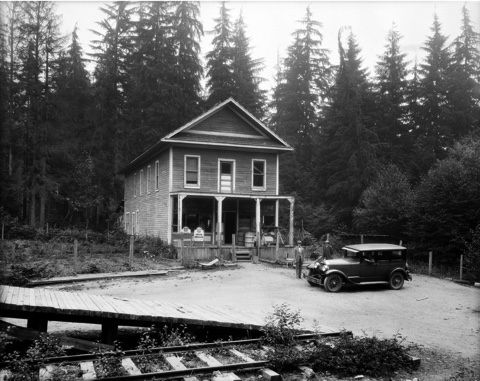Growing up in the Robe Valley, Washington, back in the 1940s and ‘50s, we neighborhood children were surrounded by reminders of the history I wrote about in Heart’s Gold, a novel set in Washington State’s gold-mining boomtown of Monte Cristo. To us kids, those reminders were just part of what made our community a fun place to live.
On warm summer days, wearing swimsuits under our clothing, we’d traipse through the woods to our swimming hole. We followed a narrow track that had once been part of the county road that ran from Granite Falls through the valley. The road took us to “Nichols Store.”
The owners had abandoned the two-story, unpainted building sometime after the present road was finished in the early 1940s, but we found ways to wriggle inside and explore the empty rooms. I could barely remember stopping there at age three or four with my parents so they could mail a letter or buy milk.

From the clearing in front rose a long, grass-covered ridge we knew had once been the railroad grade. The Everett and Monte Cristo Railway trains had stopped at Nichols Store on their way to the communities up the valley.
Climbing over the grade, we crossed a decaying bridge spanning a creek full of little fish, then walked on through a park-like area beside the river. Someone had built a picnic shelter there, perhaps in the earlier days of tourist excursions. But no one came for picnics now, except for us kids. The river ran past this grassy space and beyond lay the quiet eddy that was our swimming hole.
The remains of an old railroad-bridge buttress loomed above the hole. A deluge in 1897 had washed away the bridge, along with the dreams of miners and mine owners at Monte.
If no parents were along, after our swim we dared each other to climb up the slanting timbers to the cross pieces on top that had supported the tracks. Cushioned with moss, they made a soft place to dry off in the sunshine. We were careful though. We could feel the trestle wobble beneath us with every movement.

On the riverbank near the swimming hole was another temptation to adventurous kids—an old cable car, still attached to a fraying cable that hung above the river. The cable ran over rusty pulleys that were fastened to sturdy trees at each end. The floorboards were loose. Some were missing. Most of us could see the danger and only speculated about how much fun the ride must have been, once upon a time.
Recently I found a story in Philip R. Woodhouse’s book, Monte Cristo, about what was likely this same cable car. For quite some time following the destruction of the bridge and the railroad through the Robe Canyon, people in Silverton and Monte Cristo held onto hope that repairs could enable mining to start up again.
Temporary repairs did start in the canyon, and while awaiting replacement of the bridge, a Silverton man established his own tongue-in-cheek railroad company—a single push car. Every day he coasted down the deserted tracks from Silverton to a cable tram installed near the site of the missing bridge. Mail and supplies for Silverton were piled on the tram and sent across the river. Then he loaded them on his man-powered push car and pumped his way back to Silverton.
The cable car would have been over fifty years old when a neighbor boy talked my little brother David into taking a ride. They hauled themselves across the tumbling river without losing fingers to the cable or falling through the rotting boards. It must have been a scary trip because once safely on the far side, David refused to get back on. The older boy left him behind and got word to our father about the situation.
Fortunately in late summer, the river was not too high. But it was swift, and the rocks were slippery. Dad waded across and carried a frightened David on his back to the other side. Then Dad destroyed the tram so that no other kids would be tempted.
We didn’t know then how the old bridge abutment or the abandoned cable car tied into the story of Monte Cristo. But as young adults, we got to know the old ghost town up close and personal. It is still a favorite hiking destination for hundreds of outdoor enthusiasts. Robe Canyon and the Stillaguamish River where we played is a well-loved recreation center for many more.










 Heavily loaded logging trucks used the road, too. Everyone gave them the right of way on the twisting, mostly one lane dirt road. Brakes weren’t the best then, and you didn’t dispute the right of way with a careening log truck.”
Heavily loaded logging trucks used the road, too. Everyone gave them the right of way on the twisting, mostly one lane dirt road. Brakes weren’t the best then, and you didn’t dispute the right of way with a careening log truck.”
